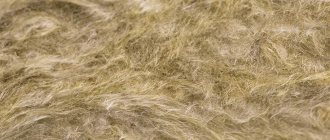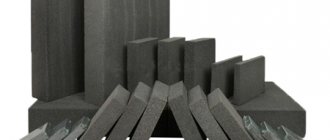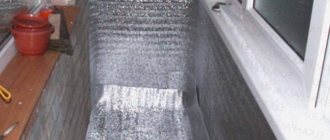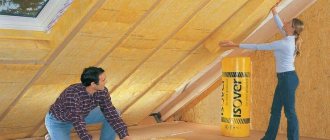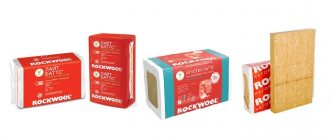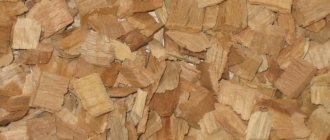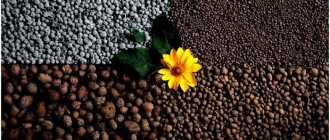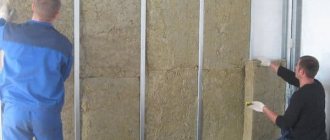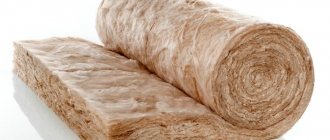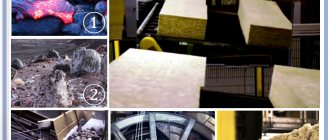general information
So, let’s first figure out what stone wool is as an insulation material.
In fact, this material has many names. Stone, basalt, mineral - all these are names for the same insulation, which consists of a soft thermal insulation material.
It is produced using different technologies. Each manufacturer has its own secrets and nuances. For example, Rockwool mineral wool and Rockwool Facade Butts insulation are created using special additives, which almost perfectly protect it from moisture. Also, Rockwool mineral wool is famous for its lightness and extreme elasticity.
However, the general technology always remains the same. The work uses basalt stone. It is an avalanche-like mineral rock.
The basalt material is melted in high-temperature furnaces, and then special resins are added to the resulting sample. As a result, fibers are formed, from which mineral wool slabs are woven.
These fibers are extremely durable, can withstand enormous loads, and do not burn. All this affects the final properties of mineral wool.
The Rockwool company has been producing mineral wool insulation for a very long time. Their technical characteristics are maximized. This is possible thanks to the use of secret technologies that have been developed over the years of the manufacturer’s presence on the market.
Rockwool mini-plates, like Shelter insulation, have enormous weight on the market and are sold out like hot cakes. And all because for this money people get exceptional quality.
Calculate the insulation of your home
A cozy home is, of course, a warm home. The level of heat loss depends on correctly calculated thermal insulation. To reduce it, it is necessary to correctly calculate the required volume of material for wall insulation and, in fact, calculate the optimal thickness of wool for insulation. The calculation of rockwool insulation for a facade can be determined in three ways:
- by contacting special construction organizations;
- on one's own;
- using an online calculator.
Of course, the easiest way is to choose the first option and save a lot of time by getting only a number. But in this case, you will have to pay a considerable amount for such services, and this, as you know, is an extra expense during construction or renovation, because you can calculate the amount of insulation yourself. Of course, it will take some time, but the result will be just as accurate.
The calculation of insulation (Scandic, Light Butts or any other) occurs according to a certain formula, and there is nothing complicated about it. It can be produced for absolutely any type of material. But first, let's look at it using a specific example.
For example, we have a brick house, the wall thickness is one and a half bricks. The work is planned to be carried out using “Light Butts” or “Scandic”. In order for thermal insulation to be effective and heat to be retained during the cold season, the wall must have a thermal resistance of at least 3.5 m2*K/W. To determine optimal thermal insulation, it is necessary to make certain calculations:
- First, we determine the current thermal resistance of the existing wall. Its thickness is 37 cm, and the thermal conductivity coefficient is 0.56. This applies to red clay bricks. So, for different types of material, thermal conductivity is usually different.
- We calculate the current thermal resistance. To do this, the wall thickness in meters must be divided by the thermal conductivity coefficient. As a result, we get: 0.37/0.56=0.66 m2*K/W.
- We are not enough to reach the optimal value of 3.5 m2*K/W: 3.5-0.66=2.84 m2*K/W.
- Next, it became possible to calculate the required thickness of the stone wool layer: 2.84 * 0.045, where the second value is the thermal conductivity coefficient of the insulation itself. Thus, we get the value in meters – 0.127. We find the value in millimeters - 127 mm. This is the required layer thickness for thermal insulation with Rockwool “Light Butts” and “Scandic” stone wool.
If you are afraid of making a mistake in your calculations, you can use an online calculator, which is offered by many construction sites.
General characteristics
Let us now look at the technical characteristics that are most often supplied with mineral wool insulation. Here we will consider only general characteristics in a highly averaged version, because there are simply a huge number of types of insulation, and each one is different in some way.
The entire range of Rockwool products
If we talk about density, then here the scatter of slabs is the greatest. The average is 50-80 kg/m3. But it all depends on the specific direction of use of the material. So, mineral wool for a pitched roof will be very light, almost airy. Accordingly, its density will be low.
And mineral wool for a flat roof will have completely different characteristics. Here the slabs already have a high density, especially when it comes to arranging a used roof.
In terms of thermal conductivity (perhaps the most important characteristic for insulation), mineral wool is at the level of 0.038-0.043 W/m, similar to Rockwool roof insulation
This is an excellent indicator, which indicates its good thermal insulation characteristics. Note that such low figures are the merit of the Rockwool company. Not all mineral wool insulation materials have the same technical parameters.
Mineral wool does not burn in fire - this applies to all its varieties. It is also hydrophobic, meaning it does not absorb water. Its water absorption coefficient ranges from 0.5 to 2% of the total mass.
It is also important to take into account the vapor permeability of mineral wool. This indicator allows it to be successfully used for arranging roofs, breathable walls and, in general, any natural structures, which can contribute to the natural regulation of the microclimate in the room.
The compression or deformation coefficient is also determined by where exactly the slabs will be used. It also interacts with density very seriously. The lower the density, the higher its indicator will be.
Thus, slabs for insulating pitched roofs have a density of 30-40 kg/m3, and their deformation coefficient is much higher. In some it reaches almost 50% (Rockwool Light Butts Scandic).
This means that the slab can be easily compressed so as to eliminate up to half of its volume. In this case, no damage to the structure will be observed.
As soon as the vector of force application disappears, the plate will immediately return to its previous position. Such solutions are also often practiced by popular companies like Rockwool, as they contribute to ease of use. In this case, you don’t even need to worry about cutting the slabs and adjusting them to the size of the frame.
In some cases, the compression coefficient of the slabs, on the contrary, is equal to only a few percent of the total volume. That is, the plate almost does not compress. This is explained by its high density and focus on receiving direct physical activity.
As for the operating temperature, the indicators here are almost always the same. Mineral wool can easily withstand temperatures from -50 to +90 degrees Celsius (Rockwool TECH BATTS is an example). It is not capable of igniting, so the highest temperature threshold rises significantly, but only if we talk about short-term loads.
Advantages of ROCKWOOL mineral wool
Thanks to the unique structure of the insulation, almost all street noises are not heard indoors.
Thermal insulation from the ROCKWOOL brand is able to compete with various materials for similar purposes due to the following qualities:
- The material is environmentally friendly despite the presence of formaldehyde salts in it. All of them go through a polymerization process, so they do not evaporate toxic gases during operation.
- It is a barrier against impact noise and vibration. Almost all outdoor work (in particular, construction) is inaudible indoors due to the unique structure of the heat-insulating layer.
- Basalt slabs practically do not get wet if they are installed correctly. Even the smallest violation of integrity can cause regular accumulation of moisture, which will result in the appearance of dampness and fungus on the walls. Therefore, it is important to properly fix the material on the surface.
- Durability of insulation. Achieved through the random placement of mineral wool fibers.
Users also note the quick and convenient installation of the heat insulator due to its unique structure.
ROCKWOOL slabs are perfectly cut without losing their factory geometric shape.
Advantages of Rockwool mineral slabs
If there is no doubt about the characteristics of basalt wool insulation, usually written on the packaging, then not every consumer is aware of all the advantages of the material. The main advantages of the plates include:
- high level of non-flammability;
- low thermal conductivity;
- energy saving;
- hydrophobicity;
- sound insulation;
- resistance to deformation;
- long service life.
Rockwool insulation boards are called non-combustible due to their resistance to high temperatures. The materials do not lose functionality at temperatures up to 1000 degrees, which allows them to be classified as non-flammable.
Rockwool mineral wool slabs have high thermal insulation properties. A material with a thickness of only 50 mm in its ability to retain heat can compete with a brick wall almost 20 times thicker!
In terms of energy saving, the stoves are no less effective. One Rockwool slab of one square meter with a standard thickness of 50 mm allows you to save up to 108 MJ of energy per year.
Thermal insulation made from Rockwool basalt wool has excellent ability to prevent moisture penetration. Upon contact with the material, moisture does not penetrate into the interior of the slab, which allows maintaining the level of thermal insulation.
Rockwool insulation also does an excellent job of absorbing noise. The material has increased acoustic properties and is able to reduce the level of sound waves of various types, improving the airborne sound insulation of the room.
It is not common for insulation to lose shape under mechanical stress due to the special placement of fibers in the vertical and horizontal planes, which in turn increases rigidity.
Among the noteworthy positive qualities, it is worth noting the long service life of the insulation. The material works significantly longer than its analogues, primarily due to its advanced technical characteristics, including resistance to biological effects.
General advantages of Rockwool insulation
Rockwool wall, internal and roof insulation has many advantages. These include:
- optimal level of thermal insulation, allowing to retain about 75% of energy;
- minimal costs (a large selection of standard sizes makes it possible to minimize waste);
- environmental Safety;
- ease of installation activities.
Materials from Rockwool compete with their analogues. They are compatible with any surface - from brick and concrete to wood and metal.
Review of the qualities of wall insulation
Basalt thermal insulation in the form of mats is considered the best option for arranging a wall pie of frame walls . The material combines the main properties: heat capacity, vapor permeability, resistance to deformation and fire.
Heat-saving effect and vapor permeability
The main advantage of “stone” mats, which determines their scope of application, is their high thermal insulation ability. Rockwool basalt wool does an excellent job of regulating the temperature inside the house. In winter, insulation protects the room from frosty air, and in summer it keeps it cool and prevents heat from penetrating inside. The insulating mats are tightly joined together. This technology prevents the appearance of cracks - cold bridges .
Elastic stone wool sheets are easy to install; additional fasteners are not needed - the layers are installed in a pre-prepared frame.
An undeniable advantage of basalt insulation is its “breathing” ability. Unlike foam insulators, natural wool is breathable . The frame does not create a thermos effect, and excess accumulated moisture is removed through the micropores of the insulation.
Moisture resistance and sound insulation
As reviews show, stone wool used for walls or on the floor delays the spread of impact and airborne noise . By choosing the optimal insulation layer, you can achieve a reduction in the sound effect within the range of 43-62 dB.
An undeniable advantage of basalt insulation is its hydrophobicity. Stone does not get wet - drops do not linger on the surface, but roll down. The material does not absorb water, which means it retains its thermal insulation qualities. This property of insulation is very important for external installation and the use of cotton wool for arranging “wet” areas: saunas, baths.
The inability to accumulate water and the mineral base of the heat insulator exclude the emergence of a favorable environment for the development of parasitic microflora, the appearance of rodents and insects. The stone wool composition is not characterized by processes of rotting, decomposition, or mold formation . Rockwool basalt mats can be reused - their characteristics and qualities are practically unchanged over time.
Fire safety and environmental friendliness
The key factor in using insulation in residential buildings is operational safety. In this regard, stone wool has succeeded.
Basalt can withstand high temperatures and does not ignite; the heat insulator begins to melt when heated from +1000°C. Rockwool insulation complies with the following safety classes:
- KM0 – completely safe;
- NG – non-combustible materials.
Due to its fire resistance, stone wool insulation is often used as an effective fire barrier .
Rockwool thermal insulator is considered an environmentally friendly product. No harmful components are involved in its production - only a natural mineral and a water repellent that ensures moisture resistance. Stone wool, regardless of operating conditions, does not emit hazardous substances into the environment. In terms of environmental friendliness, Rockwool basalt insulation is ahead of most alternative polymer-based insulation materials. Its use is permissible inside the home .
What types of Rockwool insulation are there?
The famous brand produces several types of insulation, differing in characteristics and areas of application. They are united by high quality and the presence of stone wool (mineral wool) in the composition.
Rockwool Light Butts Scandic
This material is the company’s latest development intended for private construction. The size of the plates is 80x60 mm and 120x60 mm. The thickness of the first standard size reaches 5 or 10 cm, the second - 10 and 15 cm. The insulation is suitable for insulating roof structures, interfloor ceilings, and walls. It is installed using flexi technology: it makes it possible to prevent the formation of gaps and cracks: such insulation is not susceptible to fungi, does not burn, and maintains vapor permeability.
The “flexi” technology (in English flexible means flexible, pliable, bendable) allows the slab insulation to spring: compress, quickly insert into the structure and straighten - which leads to a tight fit and leaves no gaps. This technology greatly simplifies the insulation process and reduces the amount of cuttings.
Rockwool Light Butts
Lightweight basalt insulation was created specifically for use in external structures. It has the ability to compress and unclench. This allows you to install insulation in the sheathing cells. Gaps do not form if the dimensions are met. The compression ratio of the insulation is about 30%. The thermal conductivity of this type of insulation is 0.039 W/m*k, vapor permeability is 29 mg/mhPa. It can be used for thermal insulation of attics, partitions and ceilings.
Rockslab Acoustic
Rockwool sound-absorbing boards are characterized by an optimal density of 50 kg per cubic meter. The fibers are arranged in a chaotic manner. The manufacturer took care of the homogeneity of the structure, which has a positive effect on sound absorption rates.
The material is intended to form the middle layer in the ceiling insulation pie. Its thermal conductivity is 0.037 W/m*k. The maximum compressive load can reach 0.4 kPa.
Rockwool Acoustic Butts
Rockwool sound and heat insulation is designed for hotels, cinemas, office premises, and homes. The material is ideal for fans of loud music and residents of high-rise apartments. It reduces airborne noise by up to 62 dB. The sound absorption index at 50 mm thickness reaches 0.7.
Panels from 100 to 200 mm are also on sale. There are ultra-thin slabs of 30 mm. They are used in small rooms. They can be used to cover walls and ceilings in kindergartens, schools, and hospitals.
Floor Butts
Rockwool basalt insulation with excellent soundproofing characteristics is designed for constructing a floating floor. The line offers a wide selection of panels with thicknesses from 25 to 200 mm. They do a good job of dampening impact noise.
Fireplace Butts
Rigid slabs differ from their analogues by the presence of aluminum foil insulation. Their use is advisable in close proximity to fire, and in particular near fireplaces, stoves, and furnaces. Installation inside fireplace portals is allowed at a distance of 45 mm from the firebox body. Mineral insulation can prevent the negative impact of high temperatures on the cladding and improve room heating.
Venti Butts
These are rigid hydrophobic panels. Their main area of application is the insulation of ventilated facades. It can be mounted in one or two layers. It is not necessary to include a windproof film in the design. A wide range of standard sizes of rockwool basalt insulation ensures ease of installation on any site. Disc-shaped dowels are suitable for fixing. It is advisable to maintain a distance of 25-35 mm between them.
Rockwool Roof Butts
Hydrophobized slabs consisting of two layers. The top one is hard, the bottom one is soft. This combination made it possible to reduce the weight of the panels. Their main area of application is the insulation of reinforced concrete and metal decking. The material is suitable as waterproofing.
Rockwool Standard
The price for Rockwool insulation is set at an affordable price when purchased from a representative. Despite the fact that it belongs to an exclusive line, you can buy the material cheaply. The use of standard insulation can significantly improve the indoor microclimate. Its characteristics are universal. This makes it possible to install slabs in attics, balconies, and insulate walls, floors, and ceilings.
The material is unattractive to insects and rodents, and is not susceptible to the development of bacteria and fungal spores. Its service life is several decades, without the risk of shrinkage.
Basalt is a rock formed as a result of lava outpouring. This natural mineral is very resistant to atmospheric influences, due to which it is widely used as a raw material for crushed stone, the production of basalt fiber for insulation, as well as stone casting, facing slabs, filler for concrete and in other areas.
Compressibility and bioinertness
The structure of the insulation is unique and has many air pores, so the material is easily compressed - it can change its size by 30% from its original volume. Fibers have a certain melting point, so in the event of a fire, the material will be able to protect structures from fire, inhibiting the process of pore destruction. The insulation begins to melt at 1000 °C. Rockwool insulation is also good because it is not capable of becoming a suitable environment for the life of living organisms. This applies not only to bacteria, but also to small rodents.
Features of thermal insulation materials based on mineral wool
— Low thermal conductivity. Rockwool mineral wool insulation with a heat transfer coefficient of 0.039 - 0.046 W/m*K has the property of maintaining a constant internal room temperature in the cold season and in the summer;
- High fire resistance. Mineral fibers in the boards are non-combustible materials and can withstand high temperatures, providing a high degree of fire protection for structures;
— Resistance to deformation. The material does not shrink over a long service life (up to 50 years). This property is ensured by the heterogeneous structure of the mineral wool insulation, in which the basalt fibers are located in different directions, including perpendicular to the plane of the slab;
— High noise insulation. The porous structure of rockwool stone wool provides improved sound insulation properties of structures;
— Hydrophobicity and vapor permeability. Having good vapor permeability and the ability to repel water, RockWool boards protect structures from moisture, which directly affects the increase in the service life of buildings;
- Ecological cleanliness. The use of natural raw materials in the production of insulation ensures the environmental safety of the material, which is confirmed by numerous certificates.
Installation instructions for Rockwool insulation
The main subtleties of installing Rockwool insulation depend on the location of its installation. Consider the option of installing insulation in the attic. The recommended insulation thickness is 20-35 cm. First, using a tape measure, you need to measure the distance between the beams in which the heat-insulating material will be laid. Next, the mineral wool is cut into appropriate parts using a knife.
Lay the first layer of insulation, paying attention to its contact with the edges of the beams. Next, a metal frame is installed, which will become a separator between the two layers of insulation.
After the metal frame is assembled, install the pre-cut pieces of the second layer of insulation. If necessary, install a vapor barrier, overlap it and secure with tape. Next, the attic is finished in accordance with the individual requirements of the owner of the room. Installing Rockwool insulation will save on heating the attic during the cold season.
Tips for insulating the attic:
- the installed slabs must have the same thickness;
- if several layers of slabs are installed, their seams should not match;
- press the thermal insulation material as tightly as possible to avoid the formation of cracks;
- When thermal insulation is installed incorrectly, cold bridges are formed, which lead to condensation, increase heat loss and significantly affect the duration of use of the insulation.
Based on materials from the site: fb.ru, strport.ru
Frame wall insulation technology
The basis of the house is a wooden frame, sheathed on both sides with sheet material. Between them are thermal insulation boards. Rockwool Light Butts and Rockwool Light Butts Santik are optimal for the job.
Useful: Types and main characteristics of inter-crown insulation
Wall pie laying diagram:
- installation of a vapor barrier membrane on the inside of the room;
- placement of insulation;
- wind protection fastening;
- outer skin.
The whole process consists of the four stages outlined above. Detailed instructions:
- Vapor barrier. Apply adhesive tape to the inside of the frame posts, remove the protective film and attach the membrane with an overlap of 10 cm. Additionally, secure the sheets with a stapler and glue the joints with tape .
- Laying mineral wool. Cut the insulation according to the size of the cells between the frame posts. Install heat-insulating mats, and, if necessary, install a second layer of mineral wool.
- Wind barrier installation. The membrane is attached in the same way as a vapor barrier - on adhesive tape and fixed with a stapler .
- Sheathing. To install sheet material, you need to fill the sheathing with 20*30 mm slats. Attach OSB sheets over the planks, leaving a gap of 3-5 mm between the sheets.
How to calculate thermal insulation parameters?
Calculating thermal insulation parameters is always a difficult process for a non-professional. When choosing the thickness of the insulation, it is important to take into account many criteria - wall material, climatic characteristics of the region, type of finishing material, features of the purpose and design of the area used.
There are special formulas for calculations; you can’t do without SNiPs. Leading manufacturers of thermal insulation materials have significantly simplified the process of determining thermal insulation parameters by creating special formulas.
One of the best formulas belongs to the Rockwool company. You can use it by indicating in the appropriate columns of the online calculator the type of work, the material of the insulated surface and its thickness, as well as the desired type of insulation. The program will produce the finished result in a matter of seconds.
To determine the required volumes of the heat insulator, you should calculate the area to be insulated (multiply the length and width). Once you know the area, it is easier to choose the optimal size of insulation, as well as calculate the number of mats or slabs. To insulate flat horizontal surfaces, it is more convenient to use roll modifications.
Insulation is usually purchased with a small, up to 5%, reserve in case of damage to the material and taking into account its cutting and filling the seams between the elements of the heat-insulating layer (the joints of 2 adjacent slabs).
Tips and tricks
When choosing a particular insulation, the manufacturer recommends paying attention to its density and purpose.
In addition to thermal insulation materials, the company produces waterproofing films and vapor barrier membranes. The manufacturer's recommendations and user reviews allow us to conclude that for Rockwool insulation it is better to use films and coatings from the same manufacturer. This allows for maximum compatibility of materials.
Thus, for wall insulation (Lite and Scandic) a diffuse vapor-permeable membrane is provided in regular and fire-retardant-treated versions. Special Rockwool vapor barrier is used to insulate roofs and ceilings.
When organizing a “wet” facade, you will need a special water-dispersed primer “Rockforce” , as well as “Rockglue” glue and “Rockmortar” adhesive to create a reinforcing layer. It is recommended to apply the final primer over the reinforcing layer using the Rockprimer KR mixture. As a decorative mixture, you can use the branded products “Rockdecor” (plaster) and “Rocksil” (silicone paint for facades).
Table of technical characteristics and prices for Rockwool insulation.
| LIGHT BUTTS SCANDIC* | LIGHT BUTTS* | ACOUSTIC BUTTS* | FLOR BUTTS* | FIRE BUTTS* | SAUNA BUTTS* | BUTTS FACADE* | WIRED MAT* | TECH BATTS* | RUF BUTTS* | |
| Density (types, separated by commas), kg/m3 | 30 | 35-37 | 45 | 125 | 100 | 40 | 145 | 50, 80, 105 | 90, 110 | 115, 135, 160, 190 |
| Thermal conductivity, W/(m K), λ10 | 0,036 | |||||||||
| Thermal conductivity, W/(m K), λA | 0,042 | |||||||||
| Thermal conductivity, W/(m K), λB | 0,045 | |||||||||
| Peel strength of layers, kPa | from 4 to 15 depending on the type of insulation* | |||||||||
| Compressive strength at 10% deformation, kPa | from 20 to 65 depending on the type of insulation* | |||||||||
| Vapor permeability, mg/m h Pa | 0,3 | |||||||||
| Water absorption, no more than kg/m² | 1 | |||||||||
| Service life more than 50 years | Yes | |||||||||
| Flammability degree | NG | |||||||||
| Types of construction insulate: | ||||||||||
| attics | + | + | ||||||||
| balconies | + | + | ||||||||
| loggias | + | + | ||||||||
| frame walls | + | + | ||||||||
| partitions | + | + | + | |||||||
| floors | + | + | ||||||||
| roofing | + | + | ||||||||
| floors between floors | + | + | ||||||||
| ceilings with joists | + | |||||||||
| ceilings between floors, under cement screed | + | |||||||||
| fireplaces, stoves, high-temperature equipment | + | + | + | |||||||
| piping systems, air ducts | + | + | ||||||||
| walls in steam rooms, saunas, baths | + | |||||||||
| building facades | + | |||||||||
| vertical and horizontal surfaces | + | |||||||||
| roofing | + | |||||||||
| Price per package, rub (thickness 50 mm) | 475 | 598 | 733 | 761 | 2781 (30mm) | 682 | 796 | 1230 | 925 | 955 |
* - You can always find detailed information and current prices in the Rockwool product catalog.
Technical characteristics of different types
Rockwool offers the appropriate type of insulation to solve various problems. Thermal insulation materials differ in density, size, strength, cost and other characteristics.
The most popular positions:
- Light Butts. Designed for private housing construction, insulation of non-load-bearing structures, apartments. A distinctive feature is light weight, the ability to compress the thickness up to 70%. Light Butts uses Flexi technology - to simplify installation, one edge of the sheet is springy. Density – 36 kg/m3, thermal conductivity – 0.039 W/(m*k), vapor permeability – 29 mg/(mhPa). The material is not designed for heavy loads.
- Light Butts Scandic . In terms of technical and operational characteristics, Scandic is similar to ordinary Light Butts. The differences are in size, packaging and application. The length of the Scandic reaches 80-120 cm, the XL modification simplifies installation over large areas . The improved heat insulator is sealed in vacuum-compressed packaging - this reduces logistics costs. Scandic can be used in any home insulation systems.
- Rockwool Economy. A budget solution while maintaining all the advantages of basalt wool . Characteristics: density – 23-29 kg/m3, vapor permeability – from 0.3 mg/(mhPA), size – 100*60 cm, thickness – 50 mm, 100 mm.
In addition to universal offerings, Rockwool has developed a whole line of narrowly focused products:
- façade works – Butts Optima, Butts series;
- insulation of walls under plaster – FrontRock S, FasRock LL, Lamella;
- ventilated façade – Venti Butts;
- for panel structures, monolithic buildings - Concrete Element, brickwork - Cavity Butts;
- insulation of fireplaces - Fire Butts, baths - Sauna Butts.
The Rockwool official website provides a complete list of materials broken down by category of use.
